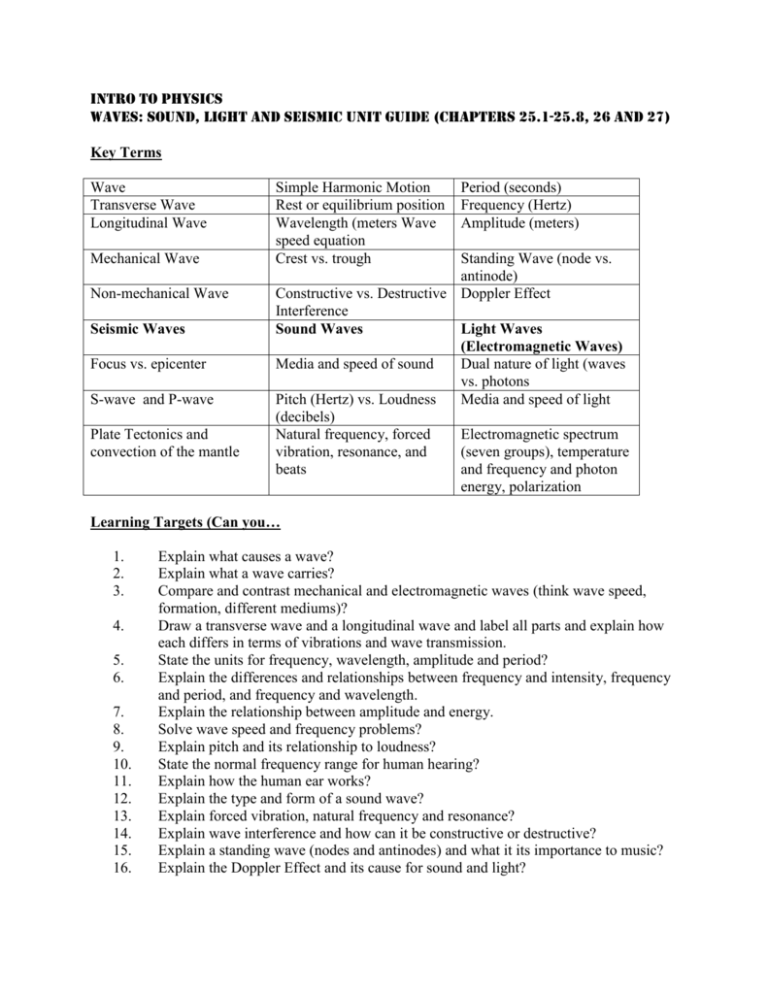Intro to Physics - Fort Thomas Independent Schools
advertisement

Intro to Physics Waves: Sound, Light and SEISMIC Unit Guide (Chapters 25.1-25.8, 26 and 27) Key Terms Wave Transverse Wave Longitudinal Wave Mechanical Wave Non-mechanical Wave Seismic Waves Focus vs. epicenter S-wave and P-wave Plate Tectonics and convection of the mantle Simple Harmonic Motion Rest or equilibrium position Wavelength (meters Wave speed equation Crest vs. trough Period (seconds) Frequency (Hertz) Amplitude (meters) Standing Wave (node vs. antinode) Constructive vs. Destructive Doppler Effect Interference Sound Waves Light Waves (Electromagnetic Waves) Media and speed of sound Dual nature of light (waves vs. photons Pitch (Hertz) vs. Loudness Media and speed of light (decibels) Natural frequency, forced Electromagnetic spectrum vibration, resonance, and (seven groups), temperature beats and frequency and photon energy, polarization Learning Targets (Can you… 1. 2. 3. 4. 5. 6. 7. 8. 9. 10. 11. 12. 13. 14. 15. 16. Explain what causes a wave? Explain what a wave carries? Compare and contrast mechanical and electromagnetic waves (think wave speed, formation, different mediums)? Draw a transverse wave and a longitudinal wave and label all parts and explain how each differs in terms of vibrations and wave transmission. State the units for frequency, wavelength, amplitude and period? Explain the differences and relationships between frequency and intensity, frequency and period, and frequency and wavelength. Explain the relationship between amplitude and energy. Solve wave speed and frequency problems? Explain pitch and its relationship to loudness? State the normal frequency range for human hearing? Explain how the human ear works? Explain the type and form of a sound wave? Explain forced vibration, natural frequency and resonance? Explain wave interference and how can it be constructive or destructive? Explain a standing wave (nodes and antinodes) and what it its importance to music? Explain the Doppler Effect and its cause for sound and light? 17. 18. 19. 20. 21. 22. 23. 24. 25. 26. 27. 28. 29. 30. Compare and contrast the two types of body seismic waves that travel through the Earth? Explain what causes earthquakes and its relationship to plate tectonics? Explain why three seismic stations are needed to find the epicenter of an earthquake? Explain what seismic evidence supports the idea that the inner core is solid and the outer core is liquid? Explain the sources of internal heat in the Earth? Explain what occurs in the mantle to cause the plates to move? Explain the three plate boundaries and what is the difference between convergence and divergence? Explain the difference between an epicenter and focus of an earthquake? In general, where do most of the major earthquakes on Earth occur? Explain how light is produced and how temperature influences the frequency and wavelength of light? List the seven groups of light on the electromagnetic spectrum. ? Explain how polarization occurs? Explain how media influences the speed of light.? Explain the dual nature of light?






